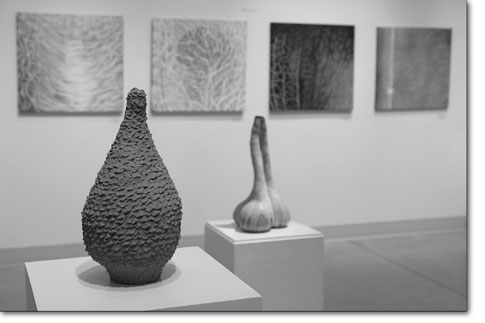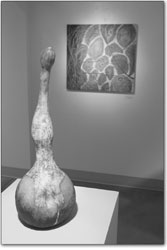| ||||
Into the mystic
by Jules Masterjohn Some experiences in life get committed to memory forever. For me, many of these unforgettable times have taken place inside some of America’s most prominent art museums, where I have taken leave of my five senses while viewing transcendental works by modern masters. One particularly memorable exhibit, “The Spiritual in Art: Abstract Painting 1890-1985,” was presented at the Los Angeles County Museum of Art in late 1986, and the exhibit has stuck with me these past 20 years. Every so often, I pull out the exhibit brochure and read through the informative essays that describe the underlying impulses involved in the creation of abstract art. This infusion of understanding acts as a quick antidote to the lingering consternation I can carry with me, having overhead a gallery goer’s skeptical comment, “My kid could do that.” Perhaps this is true, for children (and other sensitive beings called artists) are often tapped into the world’s mystical energies. As the exhibit title suggests and the brochure states, “Spiritual issues played a vital role in the genesis of abstract art, and they continue to be a motive for its creation today.” Currently on display at the Fort Lewis College Art Gallery are abstract art works inspired by the artists’ inquiries into mystical matters. “Visions at the Crossing” inhabits the gallery with ceramic sculpture by Chyako Hashimoto, of Durango, and oil paintings by Mick Lorusso, presently residing in Mexico. The two artists are longtime friends who, after seeing the similarities in their work a few years ago, decided to apply for an exhibit at FLC. One among many exhibits proposed for the fine art gallery, the work by Hashimoto and Lorusso was selected through several review processes conducted by college faculty and students. Though Hashimoto and Lorusso had always recognized their artistic kinship, the deaths of each of their fathers, within a close proximity of time, redirected their creative processes onto an even more parallel path. With their bereavement came a reorganization of their lives’ priorities and artists changed directions with their work. From their individual losses grew analogous desires to explore, as the title implies, their “Visions at the Crossing.” Hashimoto explains, “The word ‘crossing’ has multi-level meaning: that of crossing from life to death with our fathers’ passings, crossing back and forth from one culture to another, and crossing the gender line from female to male in our friendship.” This “crossing point” is also, Hashimoto clarifies, a biological term that refers to a specific point in a seed’s developmental stage, “when one side of the seed becomes the foliage and the other side becomes the root.” Hashimoto and Lorusso likened this place of differentiation to the place between life and death. The work in this exhibit has grown out of each artist’s contemplation of this “in between place.” Both Hashimoto and Lorusso engage in meditation practices, which they say enhances their awareness and guides their creative processes toward producing images of intimate revelation. Each uses an intuitive creative process, in which no preparatory sketches are made prior to beginning a piece. Rather, they travel spontaneously, through their unknown interior realms. As Hashimoto offers in her artist’s statement, “I decided to give myself permission to go where I wanted, moment by moment; to let the deeper mind express itself without conscious interference.” Hashimoto’s ceramic sculptures are a departure from her past work. Known primarily for making wheel-thrown vessels, the new body of work is built by hand using coiling and pinching methods without the aid of a potter’s wheel. Visible between each coil is a delicate line that spirals subtly, quietly around each form, a vestigial sign of the meeting place between the clay coils. Visible, too, are each of her fingerprints, reminding me of the fingertip marks impressed into the mortar of Ancestral Puebloan walls. Here the maker has left the most personal mark possible, the maker and process revealed simultaneously.
The clay forms that were born of Hashimoto’s creative contemplations are freeform, organic and pregnant with energy. They are strong and soft at the same time, the known hardness of the fired clay contradicts the seeming fleshiness of the surfaces. Her sculptures give a sense that something potent inside is pushing for release, as if Hashimoto has frozen a specific moment within a continuum of dynamic action. Some forms incorporate a small opening that acts like a doorway between the inside and out … a portal for the viewer to access her or his own energizing life force. Hashimoto is showing us where she has been, both in the moment and over time. She writes, “This process found its own end … when it was all over, the forms remained; the residue of the experience.” Lorusso, too, shows us his creative process born from deep reflection. He writes of his oil paintings, “Every successful piece takes me on a journey from the profound inner spaces of myself to the sublime outer forces of the world, and links these realms together.” His painterly expressions depict visualizations of angelic energies, which he has retrieved from his ventures into states of altered consciousness. These angelic or Judeo-Christian archetypes, taken from Gnostic and ancient texts, are meant to “link us to the unknowable” and reacquaint us with the primordial energies of angels, who are the “linkers” to profound spiritual realizations. In his paintings “Christ” and “Gabriel,” Lorusso seems to best hit his mark. These are images of vibrational fields and interconnected luminescent energy pathways. Each painting, layered with sinewy strokes of white and warm hues, convincingly alludes to a “presence” within its composition. Truly transcendental works, these two paintings hold the power to call forth from our cellular memories that which we have forgotten. • “Visions at the Crossing” is on display through Feb. 23 at the Art Gallery located in the Fine Art building at Fort Lewis College. Gallery hours are 10 a.m. to 4 p.m., Monday – Friday. For information, call 247-7167.
|



